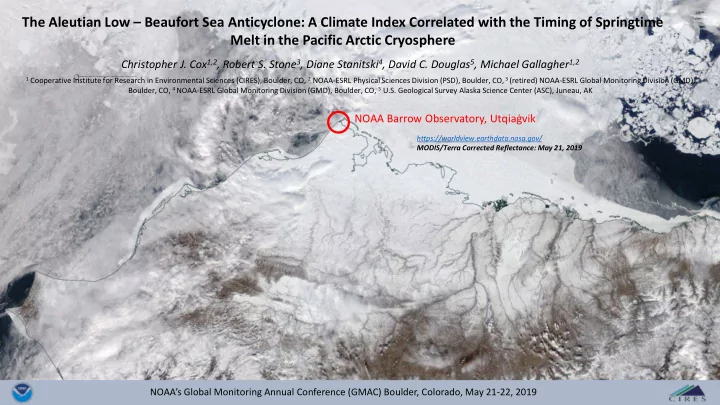

The Aleutian Low – Beaufort Sea Anticyclone: A Climate Index Correlated with the Timing of Springtime Melt in the Pacific Arctic Cryosphere Christopher J. Cox 1,2 , Robert S. Stone 3 , Diane Stanitski 4 , David C. Douglas 5 , Michael Gallagher 1,2 1 Cooperative Institute for Research in Environmental Sciences (CIRES), Boulder, CO, 2 NOAA-ESRL Physical Sciences Division (PSD), Boulder, CO, 3 (retired) NOAA-ESRL Global Monitoring Division (GMD), The linked image cannot be displayed. The file may have been moved, renamed, or deleted. Verify that the link points to the correct file and location. The linked image cannot be displayed. The file may have been moved, renamed, or deleted. Verify that the link points to the correct file and location. Boulder, CO, 4 NOAA-ESRL Global Monitoring Division (GMD), Boulder, CO, 5 U.S. Geological Survey Alaska Science Center (ASC), Juneau, AK NOAA Barrow Observatory, Utqiaġvik https://worldview.earthdata.nasa.gov/ MODIS/Terra Corrected Reflectance: May 21, 2019 NOAA’s Global Monitoring Annual Conference (GMAC) Boulder, Colorado, May 21-22, 2019
Date of snowmelt at Barrow, 1901-2018 2018 2017 2015: 4 th earliest on record 2016: 1 st earliest on record 2015 2017: latest since 1988 2018: latest since 1947 2019: ?? 2016
May Average 850 hPa GPH Late Melt Year Early Melt Year
Aleutian Low Beaufort Sea Anticyclone ALBSA = [E-W] – [N-S] N W E S Cox et al. GRL , in review
Betty Soolook, Feb 20, Diomede, AK Aleutian Low– Beaufort Sea Anticyclone (ALBSA) index Cox et al. (in review) When positive storms directed through the Bering
May 2002
Spatial Distribution of Anomalies Correlation ( r ) between ALBSA in May 1979-2017 and a combination of satellite observations; the date of snow melt derived from the Northern Hemisphere Snow Cover Extent (NH-SCE) (terrestrial regions) (Estilow et al. 2015) and the date of melt onset over sea ice derived from SSM/I passive microwave data (sea ice regions) (Markus et al. 2009).
Spatial Distribution of Anomalies Barrow Atmospheric Baseline Observatory
NSIDC Mar 1 2019 2 nd largest monthly value of ALBSA (+ or -) since 1948. Very extended period of negative values Jan -Apr, 2016. Mar 24 2016 NSIDC
ALBSA, 2019 Bering/Chukchi https://nsidc.org/ NSIDC NSIDC NSIDC Feb 1 Mar 1 Mar 21 DOY in 2019
https://worldview.earthdata.nasa.gov/ MODIS/Terra Corrected Reflectance: May 21, 2019 The linked image cannot be displayed. The file may have been moved, renamed, or deleted. Verify that the link points to the correct file and location. NOAA Barrow Observatory, Utqiaġvik NOAA’s Global Monitoring Annual Conference (GMAC) Boulder, Colorado, May 21-22, 2019
Conclusions • The Aleutian Low – Beaufort Sea Anticyclone (ALBSA) climate index has been developed to help understand the role of atmospheric circulation in modulating the timing of the loss of seasonal snowpack on the North Slope of Alaska. ALBSA is based on 850 hPa GPH at 4 points located in the North Pacific and Alaskan Arctic and is sensitive to the • juxtaposition of the Aleutian Low. The “see- saw” pattern of ice growth and retreat in the Bering and Chukchi during the 2019 winter was an • opportunity to explore the sensitivity of the index to regional wintertime sea ice variability. • Persistently positive (~ 4 weeks) ALBSA in February 2019 led a period of ice retreat. Two more periods of growth an retreat in March and April were also led by stretches negative and positive ALBSA of 1- 2 weeks. • We plan to expand the analysis of 2019 to other years to develop statistics on the relationship between ALBSA and Bering/Chukchi sea ice. • Efforts still needed to assess predictability and persistence.
Thanks! • Daily & monthly ALBSA indices based on NCEP-NCAR Reanalysis hosted online by Physical Sciences Division (PSD) Thanks to Cathy Smith (CIRES/PSD)! https://www.esrl.noaa.gov/psd/data/timeseries/ALBSA/
Recommend
More recommend